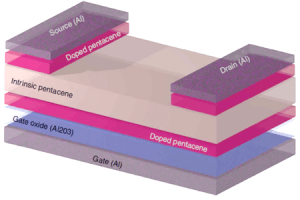 Thin film field-effect transistor is the basic device of modern microelectronics and is nowadays used more than a billion times on every state-of-the-art computer chip. In the future, this rigid technology will be complemented by flexible electronics produced at extremely low cost. With modern materials having hole mobilities of >40 cm²(Vs)‾¹ and electron mobilities of >5 cm²(Vs)‾¹, OTFTs are competing with a-Si films and have the potential to be the basic device for cheap, flexible electronics. However, they still need much improvement. The ultimate goal of organic semiconductor science is to produce materials and devices of higher quality and stability. I believe that once we can fully understand the relationship between the molecular structure and charge carrier drift mobility, we can design organic semiconductors with mobilities comparable or even exceeding state of the art CMOS technology. The upper mobility limit for the pi-pi conjugated systems is set by well known data of nearly structurally perfect graphene sheet, which yields >15,000 cm²(Vs)‾¹ at room temperature. Another challenge , which has to be addressed, for the fabrication of the complementary integrated circuits is controlled doping of organic semiconductor. Comprehensive OTFT investigations performed so far almost exclusively use electrically undoped semiconductors and OTFTs with doped channels are rarely reported. Thus influence of molecular doping on OTFT performance and stability is poorly explored. Also, reliability of OTFTs remains one of the most challenging obstacles to be overcome for broad commercial applications. So called “bias stress” effect was identified as the key instability under operation for numerous OTFT devices and interfaces. Despite a multitude of experimental observations, a comprehensive mechanism describing this behavior is still missing. Furthermore, controlled methods to overcome these instabilities are so far lacking.
Thin film field-effect transistor is the basic device of modern microelectronics and is nowadays used more than a billion times on every state-of-the-art computer chip. In the future, this rigid technology will be complemented by flexible electronics produced at extremely low cost. With modern materials having hole mobilities of >40 cm²(Vs)‾¹ and electron mobilities of >5 cm²(Vs)‾¹, OTFTs are competing with a-Si films and have the potential to be the basic device for cheap, flexible electronics. However, they still need much improvement. The ultimate goal of organic semiconductor science is to produce materials and devices of higher quality and stability. I believe that once we can fully understand the relationship between the molecular structure and charge carrier drift mobility, we can design organic semiconductors with mobilities comparable or even exceeding state of the art CMOS technology. The upper mobility limit for the pi-pi conjugated systems is set by well known data of nearly structurally perfect graphene sheet, which yields >15,000 cm²(Vs)‾¹ at room temperature. Another challenge , which has to be addressed, for the fabrication of the complementary integrated circuits is controlled doping of organic semiconductor. Comprehensive OTFT investigations performed so far almost exclusively use electrically undoped semiconductors and OTFTs with doped channels are rarely reported. Thus influence of molecular doping on OTFT performance and stability is poorly explored. Also, reliability of OTFTs remains one of the most challenging obstacles to be overcome for broad commercial applications. So called “bias stress” effect was identified as the key instability under operation for numerous OTFT devices and interfaces. Despite a multitude of experimental observations, a comprehensive mechanism describing this behavior is still missing. Furthermore, controlled methods to overcome these instabilities are so far lacking.
We investigate physical and chemical mechanisms of molecular doping and its influence on OTFT devices performance. Controlled doping of semiconductors leads to highly reproducible transistors with precisely tunable device characteristics, which is witnessed by the success of inorganic metal-oxide-semiconductor field-effect transistors. Exploiting effective n-type OTFT channel doping for p-type carrier organic semiconductor pentacene, we have recently achieved first realization of organic inversion transistors. We also presented the approach to control and significantly alleviate the bias stress effect by using interfacial molecular doping at low concentrations.
We also apply organic semiconductor friendly Orthogonal Lithography technique to fabricate ultra-short channel OTFTs and OTFT based comprehensive integrate circuit devices.
